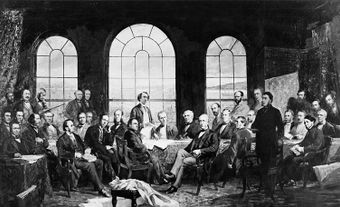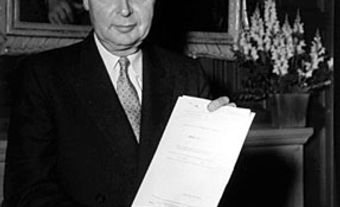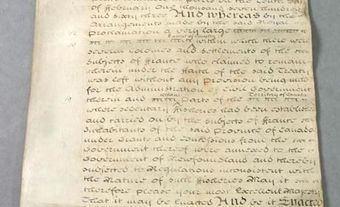
A Reformer’s Progressive Ideas
John George Lambton, the Earl of Durham, was a British political reformer. (His nickname was “Radical Jack.”) He was appointed governor general of British North America by the imperial Prime Minister, Lord Melbourne. Durham was asked to investigate colonial grievances after the rebellions of 1837–38 in Upper and Lower Canada. (See also: Rebellion in Lower Canada; Rebellion in Upper Canada.) He arrived in Canada in May 1838. However, he had a dispute with the government in London and resigned his appointment four months later. He returned to Britain. In 1839, he completed his Report on the Affairs of British North America.
The report was controversial. Its recommendations were progressive for their time. Durham proposed the creation of municipal governments and a supreme court in the British North American colonies. He also wanted to resolve the land question in Prince Edward Island. His long-held plan for the union of all BNA colonies was dropped because Nova Scotia and New Brunswick were uninterested. (It took three more decades before Durham’s vision of a BNA union was achieved through Confederation.)
Durham’s report made two main recommendations. It called for the unification of Upper and Lower Canada and the introduction of responsible government. The British Parliament implemented the first point but not the second.
Two Warring Nations
Durham believed that the problems in mostly French Lower Canada were ethnic in nature, not political. He found “two nations warring in the bosom of a single state.” Durham was culturally biased against the French Canadians. He called them “a people with no literature and no history.” He recommended assimilating them by uniting the Canadas in a way that would allow the English-speaking majority in Upper Canada to dominate. This would prevent the French Canadians from pursuing ethnic aims. It would also allow the mostly anglophone merchants in Lower Canada to pursue a strong St. Lawrence economy and ensure future prosperity. (See also: Laurentian Thesis.)
Durham believed the triumph of capitalism would bring harmony and peace. But this would also require political reforms. He believed the constitutional system In Upper Canada was defective. Power was monopolized by the Family Compact, a group of ruling elites. (Durham’s close adviser Charles Buller called them “a petty, corrupt, insolent Tory clique.”) The Family Compact had been blocking economic and social development in a potentially wealthy colony. This was a leading cause of the discontent that led to the rebellion in Upper Canada.
Durham’s solution was to introduce a system in which colonial governments, at least in domestic matters, were responsible to the electorate rather than to the governor and the Crown. This would be possible if the executive (or in modern terms, the Cabinet) was drawn from and held the support of the majority in the elected assembly. Such a reform would reduce the power of the Family Compact and stimulate colonial development. It would also strengthen the imperial connection with Britain and minimize American influence in the colony.

Responsible Government
Durham’s Report was condemned by Upper Canada’s Tory elite. However, Reformers there and in Nova Scotia hailed the idea of responsible government. In Lower Canada, Montreal’s anglophone Tories supported the union. They saw it as a way to overcome French Canadian opposition to their plans for economic development. French Canadians were opposed to the union and were determined to defend their nationality.
In the end, the British government accepted the recommendation for a union of the Canadas. (See Act of Union.) The unified Province of Canada came into being in 1841. It was governed by a joint legislature in which the newly formed Canada West (formerly Upper Canada) and Canada East (formerly Lower Canada) had an equal number of seats. But since Canada West had a smaller population, the French population in Canada East was under-represented. (See also: Rep by Pop.)
Responsible government, however, was too much for the imperial government in London. They believed that tight control of the colonies was necessary to maintain loyalty to Britain. It wasn’t until 1847 that Britain granted local self-government to the colonies. This was because a newly elected government in London was eager to reduce spending. In 1848, the Reformers in Nova Scotia, including Joseph Howe, established the first responsible government in the British Empire. (See Nova Scotia: The Cradle of Canadian Parliamentary Democracy.) Later that year, the Reformers, led by Robert Baldwin and Louis H. LaFontaine, formed a responsible government in the Province of Canada. It was later granted in New Brunswick, PEI and Newfoundland.

Significance
The Durham Report was controversial for recommending the assimilation of the French Canadians through a union of Upper and Lower Canada. Because of this, Durham became a loathed figure among French Canadians. However, his report played an important role in the development of Canadian democracy and the evolution of Canada’s political independence from Britain.

 Share on Facebook
Share on Facebook Share on X
Share on X Share by Email
Share by Email Share on Google Classroom
Share on Google Classroom


